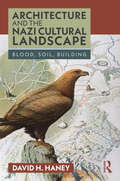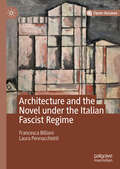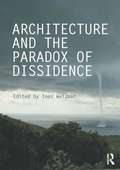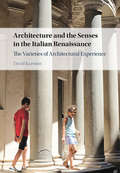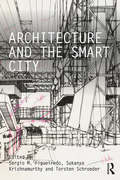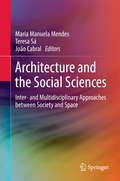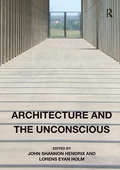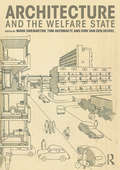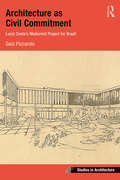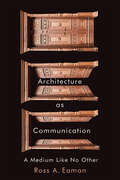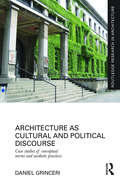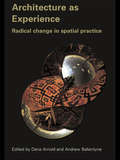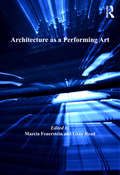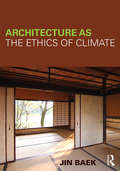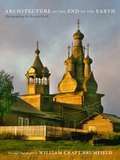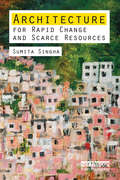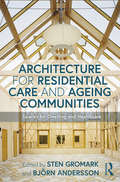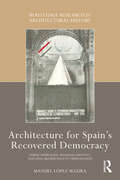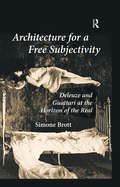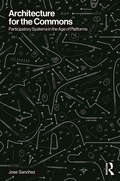- Table View
- List View
Architecture and the Nazi Cultural Landscape: Blood, Soil, Building
by David H. HaneyThis book traces cultural landscape as the manifestation of the state and national community under the Nazi regime, and how the Nazi era produced what could be referred to as a totalitarian cultural landscape. For the Nazi regime, cultural landscape was indeed a heritage resource, but it was much more than that: cultural landscape was the nation. The project of Nazi racial purification and cultural renewal demanded the physical reshaping and reconceptualization of the existing environment to create the so-called "new Nazi cultural landscape." One of the most important components of this was a set of monumental sites thought to embody blood and soil beliefs through the harmonious synthesis of architecture and landscape. This special group of "landscape-bound" architectural complexes was interconnected by the new autobahn highway system, itself thought to be a monumental work embedded in nature. Behind this intentionally aestheticized view of the nation as cultural landscape lay the all-pervasive system of deception and violence that characterized the emerging totalitarian state. This is the first historical study to consider the importance of these monumental sites together with the autobahn as evidence of key Nazi cultural and geographic strategies during the pre-war years. This book concludes by examining racial and nationalistic themes underlying cultural landscape concepts today, against this historic background.
Architecture and the Nazi Cultural Landscape: Blood, Soil, Building
by David H. HaneyThis book traces cultural landscape as the manifestation of the state and national community under the Nazi regime, and how the Nazi era produced what could be referred to as a totalitarian cultural landscape.For the Nazi regime, cultural landscape was indeed a heritage resource, but it was much more than that: cultural landscape was the nation. The project of Nazi racial purification and cultural renewal demanded the physical reshaping and reconceptualization of the existing environment to create the so-called "new Nazi cultural landscape." One of the most important components of this was a set of monumental sites thought to embody blood and soil beliefs through the harmonious synthesis of architecture and landscape. This special group of "landscape-bound" architectural complexes was interconnected by the new autobahn highway system, itself thought to be a monumental work embedded in nature. Behind this intentionally aestheticized view of the nation as cultural landscape lay the all-pervasive system of deception and violence that characterized the emerging totalitarian state.This is the first historical study to consider the importance of these monumental sites together with the autobahn as evidence of key Nazi cultural and geographic strategies during the pre-war years. This book concludes by examining racial and nationalistic themes underlying cultural landscape concepts today, against this historic background.
Architecture and the Novel under the Italian Fascist Regime
by Francesca Billiani Laura PennacchiettiArchitecture and the Novel under the Italian Fascist Regime discusses the relationship between the novel and architecture during the Fascist period in Italy (1922-1943). By looking at two profoundly diverse aesthetic phenomena within the context of the creation of a Fascist State art, Billiani and Pennacchietti argue that an effort of construction, or reconstruction, was the main driving force behind both projects: the advocated “revolution” of the novel form (realism) and that of architecture (rationalism). The book is divided into seven chapters, which in turn analyze the interconnections between the novel and architecture in theory and in practice. The first six chapters cover debates on State art, on the novel and on architecture, as well as their historical development and their unfolding in key journals of the period. The last chapter offers a detailed analysis of some important novels and buildings, which have in practice realized some of the key principles articulated in the theoretical disputes.
Architecture and the Origins of Preclassic Maya Politics
by James DoyleArchitecture and the Origins of Preclassic Maya Politics highlights the dramatic changes in the relationship of ancient Maya peoples to the landscape and to each other in the Preclassical period (ca. 2000 BC-250 AD). Offering a comprehensive history of Preclassic Maya society, James Doyle focuses on recent discoveries of early writing, mural painting, stone monuments, and evidence of divine kingship that have reshaped our understanding of cultural developments in the first millennium BC. He also addresses one of the crucial concerns of contemporary archaeology: the emergence of political authorities and their subjects in early complex polities. Doyle shows how architectural trends in the Maya Lowlands in the Preclassic period exhibit the widespread cross-cultural link between monumental architecture of imposing intent, human collaboration, and urbanism.
Architecture and the Paradox of Dissidence
by Ines WeizmanArchitecture and the Paradox of Dissidence maps out and expands upon the methodologies of architectural action and reinvigorates the concept of dissent within the architectural field. It expands the notion of dissidence to other similar practices and strategies of resistance, in a variety of historical and geographical contexts.The book also discusses how the gestures and techniques of past struggles, as well as ‘dilemmas’ of working in politically suppressive regimes, can help to inform those of today. This collection of essays from expert scholars demonstrates the multiple responses to this subject, the potential and dangers of dissidence, and thus constructs a robust lexicon of concepts that will point to possible ways forward for politically and theoretically committed architects and practitioners.
Architecture and the Politics of Gender in Early Modern Europe (Women and Gender in the Early Modern World)
by Helen HillsWritten by leading scholars in the field, the essays in this book address the relationships between gender and the built environment, specifically architecture, in early modern Europe. In recent years scholars have begun to investigate the ways in which architecture plays a part in the construction of gendered identities. So far the debates have focused on the built environment of the nineteenth and twentieth centuries to the neglect of the early modern period. This book focuses on early modern Europe, a period decisive for our understanding of gender and sexuality. Much excellent scholarship has enhanced our understanding of gender division in early modern Europe, but often this scholarship considers gender in isolation from other vital factors, especially social class. Central to the concerns of this book, therefore, is a consideration of the intersections of gender with social rank. Architecture and the Politics of Gender in Early Modern Europe makes a major contribution to the developing analysis of how architecture contributes to the shaping of social relations, especially in relation to gender, in early modern Europe.
Architecture and the Senses in the Italian Renaissance: The Varieties of Architectural Experience
by David KarmonThis is the first study of Renaissance architecture as an immersive, multisensory experience that combines historical analysis with the evidence of first-hand accounts. Questioning the universalizing claims of contemporary architectural phenomenologists, David Karmon emphasizes the infinite variety of meanings produced through human interactions with the built environment. His book draws upon the close study of literary and visual sources to prove that early modern audiences paid sustained attention to the multisensory experience of the buildings and cities in which they lived. Through reconstructing the Renaissance understanding of the senses, we can better gauge how constant interaction with the built environment shaped daily practices and contributed to new forms of understanding. Architecture and the Senses in the Italian Renaissance offers a stimulating new approach to the study of Renaissance architecture and urbanism as a kind of 'experiential trigger' that shaped ways of both thinking and being in the world.
Architecture and the Smart City
by Sergio M. Figueiredo Sukanya Krishnamurthy Torsten SchroederIncreasingly the world around us is becoming ‘smart.’ From smart meters to smart production, from smart surfaces to smart grids, from smart phones to smart citizens. ‘Smart’ has become the catch-all term to indicate the advent of a charged technological shift that has been propelled by the promise of safer, more convenient and more efficient forms of living. Most architects, designers, planners and politicians seem to agree that the smart transition of cities and buildings is in full swing and inevitable. However, beyond comfort, safety and efficiency, how can ‘smart design and technologies’ assist to address current and future challenges of architecture and urbanism? Architecture and the Smart City provides an architectural perspective on the emergence of the smart city and offers a wide collection of resources for developing a better understanding of how smart architecture, smart cities and smart systems in the built environment are discussed, designed and materialized. It brings together a range of international thinkers and practitioners to discuss smart systems through four thematic sections: ‘Histories and Futures’, ‘Agency and Control’, ‘Materialities and Spaces’ and ‘Networks and Nodes’. Combined, these four thematic sections provide different perspectives into some of the most pressing issues with smart systems in the built environment. The book tackles questions related to the future of architecture and urbanism, lessons learned from global case studies and challenges related to interdisciplinary research, and critically examines what the future of buildings and cities will look like.
Architecture and the Social Sciences: Inter- and Multidisciplinary Approaches between Society and Space
by Maria Manuela Mendes Teresa Sá João CabralThis book contributes to current debates on the relationship between architecture and the social sciences, highlighting current interdisciplinary and transdisciplinary teaching as well as research and practice in architecture and urbanism. It also raises awareness about the complementarities and tensions between the spaces of the project, including the construction spaces and living space. It gives voice to recent projects and socio-territorial interventions, focusing on interdisciplinary and multidisciplinary approaches between society and space. Divided into two parts, the first part discusses the possible dialogue between social sciences and architecture, while the second part explores architecture, politics and social change in urban territories from a European perspective.
Architecture and the Unconscious
by John Shannon Hendrix Lorens Eyan HolmThere are a number of recent texts that draw on psychoanalytic theory as an interpretative approach for understanding architecture, or that use the formal and social logics of architecture for understanding the psyche. But there remains work to be done in bringing what largely amounts to a series of independent voices, into a discourse that is greater than the sum of its parts, in the way that, say, the architect Peter Eisenman was able to do with the architecture of deconstruction or that the historian Manfredo Tafuri was able to do with the Marxist critique of architecture. The discourse of the present volume focuses specifically for the first time on the subject of the unconscious in relation to the design, perception, and understanding of architecture. It brings together an international group of contributors, who provide informed and varied points of view on the role of the unconscious in architectural design and theory and, in doing so, expand architectural theory to unexplored areas, enriching architecture in relation to the humanities. The book explores how architecture engages dreams, desires, imagination, memory, and emotions, how architecture can appeal to a broader scope of human experience and identity. Beginning by examining the historical development of the engagement of the unconscious in architectural discourse, and the current and historical, theoretical and practical, intersections of architecture and psychoanalysis, the volume also analyses the city and the urban condition.
Architecture and the Welfare State
by Tom Avermaete Mark Swenarton Dirk van den HeuvelIn the decades following World War Two, and in part in response to the Cold War, governments across Western Europe set out ambitious programmes for social welfare and the redistribution of wealth that aimed to improve the everyday lives of their citizens. Many of these welfare state programmes - housing, schools, new towns, cultural and leisure centres – involved not just construction but a new approach to architectural design, in which the welfare objectives of these state-funded programmes were delineated and debated. The impact on architects and architectural design was profound and far-reaching, with welfare state projects moving centre-stage in architectural discourse not just in Europe but worldwide. This is the first book to explore the architecture of the welfare state in Western Europe from an international perspective. With chapters covering Austria, Belgium, France, Germany, Italy, The Netherlands, Sweden and the UK, the book explores the complex role played by architecture in the formation and development of the welfare state in both theory and practice. Themes include: the role of the built environment in the welfare state as a political project the colonial dimension of European welfare state architecture and its ‘export’ to Africa and Asia the role of welfare state projects in promoting consumer culture and economic growth the picture of the collective produced by welfare state architecture the role of architectural innovation in the welfare state the role of the architect, as opposed to construction companies and others, in determining what was built the relationship between architectural and social theory the role of internal institutional critique and the counterculture. Contributors include: Tom Avermaete, Eve Blau, Nicholas Bullock, Miles Glendinning, Janina Gosseye, Hilde Heynen, Caroline Maniaque-Benton, Helena Mattsson, Luca Molinari, Simon Pepper, Michelle Provoost, Lukasz Stanek, Mark Swenarton, Florian Urban and Dirk van den Heuvel.
Architecture as Civil Commitment: Lucio Costa's Modernist Project for Brazil (Ashgate Studies in Architecture)
by Gaia PiccaroloArchitecture as Civil Commitment analyses the many ways in which Lucio Costa shaped the discourse of Brazilian modern architecture, tracing the roots, developments, and counter-marches of a singular form of engagement that programmatically chose to act by cultural means rather than by political ones. Split into five chapters, the book addresses specific case-studies of Costa’s professional activity, pointing towards his multiple roles in the Brazilian federal government and focusing on passages of his work that are much less known outside of Brazil, such as his role inside Estado Novo bureaucracy, his leadership at SPHAN, and his participation in UNESCO’s headquarters project, all the way to the design of Brasilia. Digging deep into the original documents, the book crafts a powerful historical reconstruction that gives the international readership a detailed picture of one of the most fascinating architects of the 20th century, in all his contradictory geniality. It is an ideal read for those interested in Brazilian modernism, students and scholars of architectural and urban planning history, socio-cultural and political history, and visual arts.
Architecture as Communication: A Medium Like No Other
by Ross A. EamanMedia theory has long overlooked the built environment and its communicative capacity: how built structures and spaces convey meaning through material embodiment and symbolization.Architecture as Communication advances the idea that built environments function as media of communication. Using practice theory in conjunction with the concept of style, this book is anchored in three historical determinants: the quest for perfect proportion in buildings, the belief in architectural determinism, and the ongoing efforts within other media to influence how those who experience built environments understand them. Ross Eaman explores how houses, schools, places of worship, factories, office buildings, stores, malls, opera houses, plazas, and parks have meaning for people as subjective life-worlds. Architecture as Communication proposes media theory that articulates the social construction of meaning as a unique way of understanding the built environment – one in which the users and observers of structures and spaces participate along with architects and designers. Architecture, according to Eaman, encompasses the multiplicity of communication as human interaction, preparing people for what they are about to encounter, signalling how they should act, and selectively enabling them to perform their expected role.Using examples across many historical periods and cultures, Architecture as Communication argues that we judge our built environments by the values they communicate.
Architecture as Cultural and Political Discourse: Case studies of conceptual norms and aesthetic practices (Routledge Research in Architecture)
by Daniel GrinceriThis book is concerned with cultural and political discourses that affect the production of architecture. It examines how these discursive mechanisms and technologies combine to normalise and aestheticise everyday practices. It queries the means by which buildings are appropriated to give shape and form to political aspirations and values. Architecture is not overtly political. It does not coerce people to behave in certain ways. However, architecture is constructed within the same rules and practices whereby people and communities self-govern and regulate themselves to think and act in certain ways. This book seeks to examine these rules through various case studies including: the reconstructed Notre Dame Cathedral, the Nazi era Munich Konigsplatz, Auschwitz concentration camp and the Prora resort, Sydney’s suburban race riots, and the Australian Immigration Detention Centre on Christmas Island.
Architecture as Experience: Radical Change in Spatial Practice
by Dana Arnold Andrew BallantyneArchitecture as Experience investigates the perception and appropriation of places across intervals of time and culture. The particular concern of the volume is to bring together fresh empirical research and animate it through contact with theoretical sophistication, without overwhelming the material. The chapters establish the continuity of a particular physical object and show it in at least two alternative historical perspectives, in which recognisable features are shown in different lights. The results are often surprising, inverting the common idea of a historic place as having an enduring meaning. This book shows the insight that can be gained from learning about earlier constructions of meaning which have been derived from the same buildings that stand before us today.
Architecture as a Performing Art (Ashgate Studies In Architecture Ser.)
by Gray Read Marcia FeuersteinHow do buildings act with people and among people in the performances of life? This collection of essays reveals a deep alliance between architecture and the performing arts, uncovering its roots in ancient stories, and tracing a continuous tradition of thought that emerges in contemporary practice. With fresh insight, the authors ask how buildings perform with people as partners, rather than how they look as formal compositions. They focus on actions: the door that offers the possibility of making a dramatic entrance, the window that frames a scene, and the city street that is transformed in carnival. The essays also consider the design process as a performance improvised among many players and offer examples of recent practice that integrates theater and dance. This collection advances architectural theory, history, and criticism by proposing the lens of performance as a way to engage the multiple roles that buildings can play, without reducing them to functional categories. By casting architecture as spatial action rather than as static form, these essays open a promising avenue for future investigation. For architects, the essays propose integrating performance into design through playful explorations that can reveal intense relationships between people and place, and among people in place. Such practices develop an architectural imagination that intuitively asks, 'How might people play out their stories in this place?' and 'How might this place spark new stories?' Questions such as these reside in the heart of all of the essays presented here. Together, they open a position in the intersection between everyday life and staged performance to rethink the role of architectural design.
Architecture as the Ethics of Climate
by Jin BaekAt a time when climate and ethics have become so important to architectural debate, this book proposes an entirely new way for architects to engage with these core issues. Drawing on Tetsuro Watsuji‘s (1889-1960) philosophy, the book illuminates climate not as a collection of objective natural phenomena, but as a concrete form of bond in which "who we are"—the subjective human experience—is indivisibly intertwined with the natural phenomena. The book further elucidates the inter-personal nature of climatic experiences, criticizing a view that sees atmospheric effects of climate under the guise of personal experientialism and reinforcing the linkage between climate and ethos as the appropriateness of a setting for human affairs. This ethical premise of climate stretches the horizon of sustainability as pertaining not only to man’s solitary relationship with natural phenomena—a predominant trend in contemporary discourse of sustainability—but also to man’s relationship with man. Overcoming climatic determinism—regional determinism, too—and expanding the ethics of the inter-personal to the level where the whole and particulars are joined through the dialectics of the mutually-negating opposites, Jin Baek develops a new thesis engaging with the very urgent issues inherent in sustainable architecture. Crucially, the book explores examples that join climate and the dynamics of the inter-personal, including: Japanese vernacular residential architecture the white residential architecture of Richard Neutra contemporary architectural works and urban artifacts by Tadao Ando and Aldo Rossi Beautifully illustrated, this book is an important contribution to the discourse which surrounds architecture, climate and ethics and encourages the reader to think more broadly about how to respond to the current challenges facing the profession.
Architecture at the End of the Earth: Photographing the Russian North
by William Craft BrumfieldCarpeted in boreal forests, dotted with lakes, cut by rivers, and straddling the Arctic Circle, the region surrounding the White Sea, which is known as the Russian North, is sparsely populated and immensely isolated. It is also the home to architectural marvels, as many of the original wooden and brick churches and homes in the region's ancient villages and towns still stand. Featuring nearly two hundred full color photographs of these beautiful centuries-old structures, Architecture at the End of the Earth is the most recent addition to William Craft Brumfield's ongoing project to photographically document all aspects of Russian architecture.The architectural masterpieces Brumfield photographed are diverse: they range from humble chapels to grand cathedrals, buildings that are either dilapidated or well cared for, and structures repurposed during the Soviet era. Included are onion-domed wooden churches such as the Church of the Dormition, built in 1674 in Varzuga; the massive walled Transfiguration Monastery on Great Solovetsky Island, which dates to the mid-1550s; the Ferapontov-Nativity Monastery's frescoes, painted in 1502 by Dionisy, one of Russia's greatest medieval painters; nineteenth-century log houses, both rustic and ornate; and the Cathedral of St. Sophia in Vologda, which was commissioned by Ivan the Terrible in the 1560s. The text that introduces the photographs outlines the region's significance to Russian history and culture.Brumfield is challenged by the immense difficulty of accessing the Russian North, and recounts traversing sketchy roads, crossing silt-clogged rivers on barges and ferries, improvising travel arrangements, being delayed by severe snowstorms, and seeing the region from the air aboard the small planes he needs to reach remote areas.The buildings Brumfield photographed, some of which lie in near ruin, are at constant risk due to local indifference and vandalism, a lack of maintenance funds, clumsy restorations, or changes in local and national priorities. Brumfield is concerned with their futures and hopes that the region's beautiful and vulnerable achievements of master Russian carpenters will be preserved. Architecture at the End of the Earth is at once an art book, a travel guide, and a personal document about the discovery of this bleak but beautiful region of Russia that most readers will see here for the first time.
Architecture for Rapid Change and Scarce Resources
by Sumita SinhaArchitects, development practitioners and designers are working in a global environment and issues such as environmental and cultural sustainability matter more than ever. Past interactions and interventions between developed and developing countries have often been unequal and inappropriate. We now need to embrace fresh design practices based on respect for diversity and equality, participation and empowerment. This book explores what it means for development activists to practise architecture on a global scale, and provides a blueprint for developing architectural practices based on reciprocal working methods. The content is based on real situations - through extended field research and contacts with architecture schools and architects, as well as participating NGOs. It demonstrates that the ability to produce appropriate and sustainable design is increasingly relevant, whether in the field of disaster relief, longer-term development or wider urban contexts, both in rich countries and poor countries.
Architecture for Residential Care and Ageing Communities: Spaces for Dwelling and Healthcare
by Sten Gromark; Björn AnderssonArchitecture for Residential Care and Ageing Communities confronts urgent architectural design challenges within residential innovation, ageing communities and healthcare environments. The increasing and diversified demands on the housing market today call for alterability and adaptability in long term solutions for new integrated ways of residing. Meanwhile, an accentuated ageing society requires new residential ways of living, combining dignity, independence and appropriate care. Concurrently, profound changes in technical conditions for home healthcare require rethinking healing environments. This edited collection explores the dynamics between these integrated architectural and caring developments and intends to envision reconfigured environmental design patterns that can significantly enhance new forms of welfare and ultimately, an improved quality of life. This book identifies, presents, and articulates new qualities in designs, in caring processes, and healing atmospheres, thereby providing operational knowledge developed in close collaboration with academics, actors and stakeholders in architecture, design, and healthcare. This is an ideal read for those interested in health promotive situations of dwelling, ageing and caring.
Architecture for Spain's Recovered Democracy: Public Patronage, Regional Identity, and Civic Significance in 1980s Valencia (Routledge Research in Architectural History)
by Manuel López SeguraHistorical studies on the involvement of architecture in twentieth-century politics have overlooked its contribution to building Spain’s democracy. This pioneering book seeks to fill that void. Between the late 1970s and early 1990s, Spain founded representative institutions, launched its welfare state, and devolved autonomy to its regions. The study brings forth the architectural incarnation of that threefold program as it deployed in the Valencian Country, a Catalan-speaking region on Spain’s Mediterranean shores. There, social democratic authorities mobilized architects, planners, and graphic artists to devise a newly open public sphere and to recover a local identity that Franco’s dictatorship had repressed for decades. The research follows the impetus of reform and its contradictions through urban projects, designs for cultural amenities, and the renovation of governmental and professional bodies. Architecture for Spain’s Recovered Democracy contributes to current debates on nationalism and the arts, the environments of democratic socialism, and postmodernism and neoliberalism. As a result, it widens our understanding of how peripheral regions may yield egalitarian architectures of resistance. This book is written for students and researchers in architecture and planning, art history, spatial politics, and Hispanic studies, as well as for a general readership interested in inclusive politics in the built environment.
Architecture for a Free Subjectivity: Deleuze and Guattari at the Horizon of the Real
by Simone BrottArchitecture for a Free Subjectivity reformulates the French philosopher Gilles Deleuze's model of subjectivity for architecture, by surveying the prolific effects of architectural encounter, and the spaces that figure in them. For Deleuze and his Lacanian collaborator Félix Guattari, subjectivity does not refer to a person, but to the potential for and event of matter becoming subject, and the myriad ways for this to take place. By extension, this book theorizes architecture as a self-actuating or creative agency for the liberation of purely "impersonal effects." Imagine a chemical reaction, a riot in the banlieues, indeed a walk through a city. Simone Brott declares that the architectural object does not merely take part in the production of subjectivity, but that it constitutes its own. This book is to date the only attempt to develop Deleuze's philosophy of subjectivity in singularly architectural terms. Through a screening of modern and postmodern, American and European works, this provocative volume draws the reader into a close encounter with architectural interiors, film scenes, and other arrangements, while interrogating the discourses of subjectivity surrounding them, and the evacuation of the subject in the contemporary discussion. The impersonal effects of architecture radically changes the methodology, just as it reimagines architectural subjectivity for the twenty-first century.
Architecture for the Commons: Participatory Systems in the Age of Platforms
by Jose SanchezArchitecture for the Commons dives into an analysis of how the tectonics of a building is fundamentally linked to the economic organizations that allow them to exist. By tracing the origins and promises of current technological practices in design, the book provides an alternative path, one that reconsiders the means of achieving complexity through combinatorial strategies. This move requires reconsidering serial production with crowdsourcing and user content in mind. The ideas presented will be explored through the design research developed within Plethora Project, a design practice that explores the use of video game interfaces as a mechanism for participation and user design. The research work presented throughout the book seeks to align with a larger project that is currently taking place in many different fields: The Construction of the Commons. By developing both the ideological and physical infrastructure, the project of the Commons has become an antidote to current economic practices that perpetuate inequality. The mechanisms of the production and governance of the Commons are discussed, inviting the reader to get involved and participate in the discussion. The current political and economic landscape calls for a reformulation of our current economic practices and alternative value systems that challenge the current market monopolies. This book will be of great interest not only to architects and designers studying the impact of digital technologies in the field of design but also to researchers studying novel techniques for social participation and cooperating of communities through digital networks. The book connects principles of architecture, economics and social sciences to provide alternatives to the current production trends.
Architecture from Commission to Construction
by Jennifer HudsonThis book provides an in-depth study of the design and construction processes behind 25 leading contemporary buildings. Covering a broad range of international projects, the book illustrates the working methods and creative concerns of both long-established and emerging international architects. Every stage of each project is included, from the demands of the original brief, through early sketches and design development to investigation of building regulations and collaboration with engineers, contractors, builders and clients. Each project is presented through an explanatory overview, sketches, details, CAD renderings, models and construction shots, all captioned in great technical detail. Architecture from Commission to Construction offers both students and professional architects an inspiring and informative overview of how today's major architectural projects are designed and built.
Architecture from Commission to Construction: From Commission To Construction
by Jennifer HudsonThis book provides an in-depth study of the design and construction processes behind 25 leading contemporary buildings. Covering a broad range of international projects, the book illustrates the working methods and creative concerns of both long-established and emerging international architects. Every stage of each project is included, from the demands of the original brief, through early sketches and design development to investigation of building regulations and collaboration with engineers, contractors, builders and clients. Each project is presented through an explanatory overview, sketches, details, CAD renderings, models and construction shots, all captioned in great technical detail. Architecture from Commission to Construction offers both students and professional architects an inspiring and informative overview of how today's major architectural projects are designed and built.
